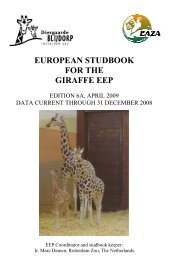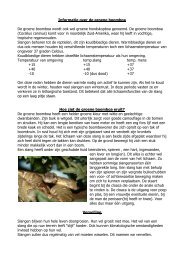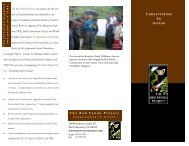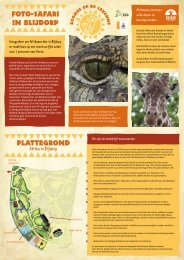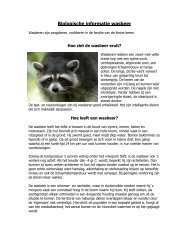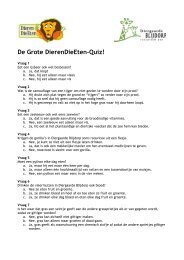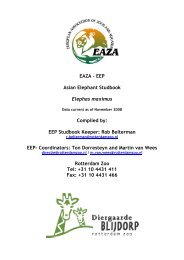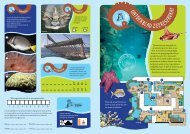Create successful ePaper yourself
Turn your PDF publications into a flip-book with our unique Google optimized e-Paper software.
EUROPEAN STUDBOOK CROWNED PIGEONS<br />
5.3 Nutrition<br />
One of the explanations for the slow natural growth of the population of crowned pigeons in<br />
captivity might be a difference between nutrition of crowned pigeons in captivity and in the wild.<br />
Therefore, in 1995, Anneke Hallebeek, who is now working at the University of Utrecht, compared<br />
the nutrition of a lot of European zoos (Hallebeek, 1995). In 1997, a research project was carried<br />
out in Papua New Guinea by Marc Damen to study the ecology of crowned pigeons in the wild. He<br />
also sampled some crop and stomach contents from crowned pigeons for analysing. More<br />
information about this subject can be found in the previous numbers of the European <strong>Studbook</strong> of<br />
Crowned Pigeons.<br />
Literature<br />
Because of their size and ecology and because there are only a few notes about feeding in the wild,<br />
the diet of turkeys is used as a guideline to determine the need of crowned pigeons. According to<br />
Robbins from the University of San Diego, the daily need for energy for non-migratory nonproductive<br />
birds in general, kept under a temperature of 25 degrees Celsius is 330.1xG 0.75 (Klasing,<br />
1998), which should mean for a mature crowned pigeon of 2.5 kg a total of 2,7 MJ metabolizable<br />
energy per day (Griminger, 1983). The need for protein based on data for non-productive laying<br />
hens and turkeys should be approximately 25 grams per day and of course higher in the<br />
reproductive season (National Research Institute, 1984). Because of the short caeca of crowned<br />
pigeons, the vitamin B synthesis might be insufficient and therefore in comparison with poultry the<br />
food has to be supplemented with at least vitamin B 6 and B 12 (Hallebeek, 1995). Some institutions<br />
also add vitamin C, because it became evident that birds, when stressed, are unable to produce<br />
enough vitamin C (Van Gennip, 1988). Research showed that birds, which are being kept indoors,<br />
have a higher demand for vitamins (National Research Institute, 1984).<br />
Practice in zoos and birdparks<br />
In 1995 a questionnaire was sent out to all participants in the crowned pigeon EEP. Apart from<br />
questions about nutrition, a lot of other factors were studied, like the size of the enclosure, other<br />
species kept in the same enclosure, number and sex ratio of the crowned pigeons in the enclosure<br />
and of course breeding results, because the aim of the questionnaire was to determine an optimal<br />
diet for crowned pigeons. The following data have been derived from the results from the<br />
questionnaires.<br />
The daily need for energy seems to be 1.5 MJ metabolizable energy per day. Because 55-60% of<br />
the gross energy should be metabolizable, the gross energy intake should be 2.5 MJ per day. The<br />
average food intake of adult crowned pigeons is about 250 grams with 40% dry matter. The best<br />
results were achieved in institutions that supply the crowned pigeons with a diet consisting of 9-11<br />
g crude protein per MJ metabolizable energy for maintenance (approx. 15 grams per day) and 11-<br />
14 grams for production (20 grams per day) (Hallebeek, 1995).<br />
Especially the ratio of calcium was low: the German researcher Meyer advised a need for<br />
calcium for maintenance for pigeons of 0.8 grams per MJ metabolizable energy, which means<br />
about 1.2 grams calcium per day for a bird of 2.5 kg. Most diets for crowned pigeons only contain<br />
less than 0.5 gram of calcium per day, but it might be possible that some zoos feed their pigeons<br />
additional mineral stones or lime stones or oyster shells and did not list this on the questionnaire. A<br />
deficiency of calcium causes a decalcification of the skeleton. Of course it is simple to add some<br />
mineral stones to the food. Calcium can only be converted if a sufficient amount of vitamin D is<br />
supplied. In most cases less than 74 International Units vitamin D per MJ metabolizable energy is<br />
supplied. As a result of this the Ca : P ratio in most diets is not that good (Hallebeek, 1995).<br />
164



